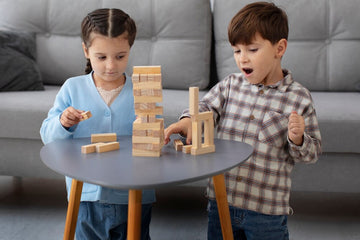Wooden Toys vs. Digital Toys: Striking a Balance in the Digital Age

In an increasingly digital world, where screens dominate our daily lives, it is crucial to find a balance between the benefits of technology and the importance of hands-on, screen-free play for children. In this blog post, we will delve into the debate of wooden toys versus digital toys, highlighting the drawbacks of excessive screen time and the numerous benefits of incorporating traditional wooden toys into children's lives.
The Impact of Excessive Screen Time: Excessive screen time has become a growing concern in the digital age. Prolonged exposure to screens can hinder a child's physical, cognitive, and emotional development. It may lead to sedentary lifestyles, poor social interactions, reduced creativity, and diminished attention spans. By relying solely on digital toys, children miss out on valuable opportunities for hands-on exploration and active engagement with the physical world around them.
The Power of Hands-On Play: Wooden toys offer a tangible and immersive play experience that encourages children to use their imagination, creativity, and problem-solving skills. They provide opportunities for sensory stimulation, spatial awareness, and fine motor development. Whether it's building with blocks, assembling puzzles, or role-playing with dolls, hands-on play with wooden toys fosters independence, critical thinking, and social interaction. These activities promote holistic development and lay the foundation for a well-rounded skill set.
Encouraging Creativity and Imagination: Digital toys often come pre-programmed with specific functions and limit a child's ability to think freely and creatively. In contrast, wooden toys offer open-ended play possibilities, allowing children to explore various scenarios, create their narratives, and let their imagination run wild. With wooden toys, children become active participants in their play, developing storytelling skills, problem-solving abilities, and a sense of autonomy.
Developing Fine Motor Skills and Coordination: Manipulating and interacting with wooden toys requires physical dexterity, hand-eye coordination, and fine motor skills. Whether it's stacking blocks, fitting puzzle pieces together, or maneuvering small figurines, children enhance their motor skills through tactile experiences. These activities strengthen muscles, improve hand-eye coordination, and lay the foundation for future academic tasks such as writing and drawing.
Screen-Free Social Interaction: Wooden toys encourage social interaction and collaboration among children. They foster cooperative play, turn-taking, and negotiation skills. Unlike digital toys that isolate children in individual screen-focused experiences, wooden toys facilitate face-to-face interactions, imaginative play with peers, and the development of essential social skills.
Conclusion:
In the digital age, it is vital to strike a balance between digital toys and traditional wooden toys. While digital toys offer some benefits, they should not overshadow the importance of hands-on, screen-free play. Wooden toys provide a range of advantages, including enhanced creativity, improved fine motor skills, and the promotion of social interaction. By incorporating wooden toys into children's lives, we can offer them a well-rounded play experience that nurtures their physical, cognitive, and emotional development. Let's encourage children to engage in the joy of tangible play and create a harmonious balance between the digital world and the enriching realm of wooden toys.




